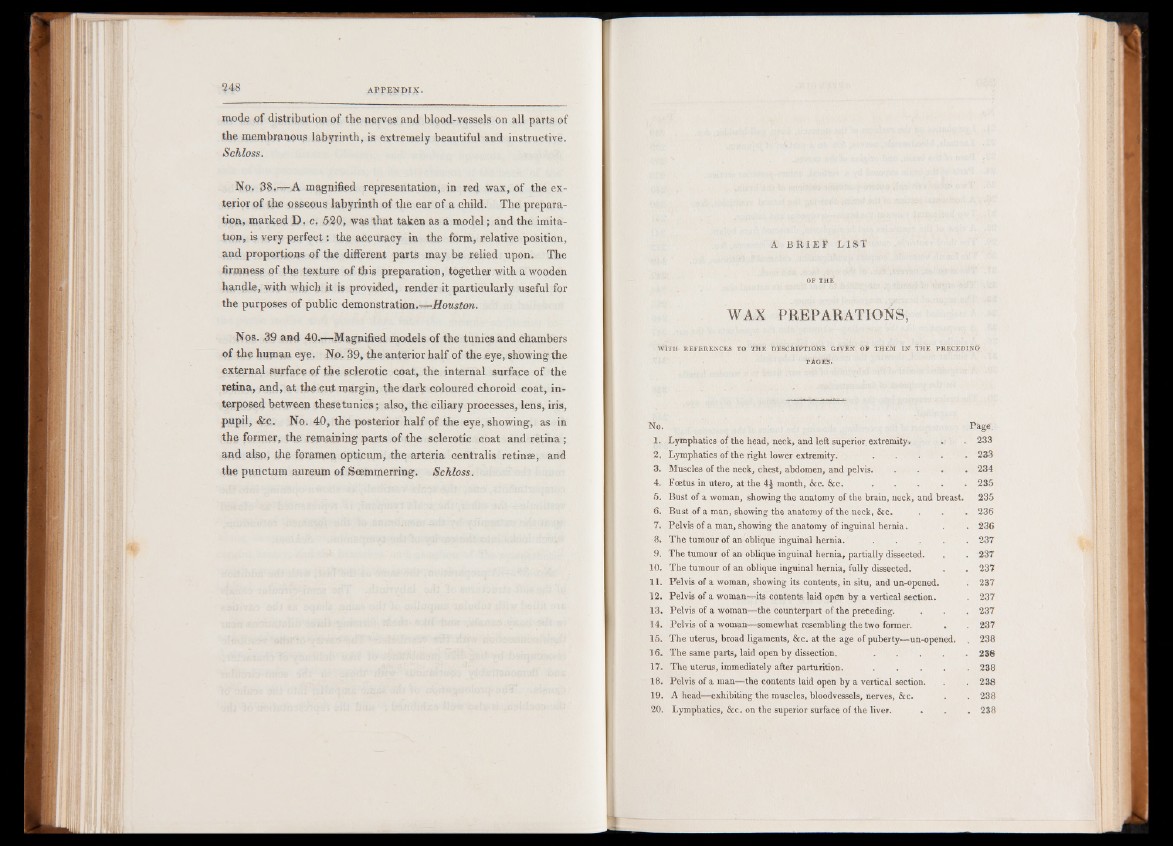
mode of distribution of the nerves and blood-vessels on all parts of
the membranous labyrinth, is extremely beautiful and instructive.
Schloss.
No, 38.—A magnified representation, in red wax, of the exterior
of the osseous labyrinth of the ear of a child. The preparation,
marked D, c, 520, was that taken as a model; and the imitation,
is very perfect: the accuracy in the form, relative position,
and proportions of the different parts may be relied upon. The
firmness of the texture of this preparation, together with a wooden
handle, with which it is provided, render it particularly useful for
the purposes of public demonstration.—Houston.
Nos. 39 and 40.-—Magnified models of the tunics and chambers
of the human eye. No. 39, the anterior half of the eye, showing the
external surface of the sclerotic coat, the internal surface of the
retina, and, at the cut margin, the dark coloured choroid coat, interposed
between these tunics; also, the ciliary processes, lens, iris,
pupil, &c. No. 40, the posterior half of the eye, showing, as in
the former, the remaining parts of the sclerotic coat and retina ;
and also, the foramen opticum, the arteria centralis retinae, and
the punctual aureum of Seemmerring. Schloss.
A B R I E F LI S T
OF THE
WAX PREPARATIONS,
WITH REFERENCES TO THE DESCRIPTIONS GIVEN OF THEM IN THE PRECEDING
PAGES.
No. Page
1 Lymphatics of the head, neck, and left superior, extremity. . . 233
2. Lymphatics of the right lower extremity. . . . . . 233
3. Muscles of the neck, chest, abdomen, and pelvis. . . . . 234
4. Foetus in utero, at the 4J month, &c. &c. . . . . . 235
5. Bust of a woman, showing the anatomy of the brain, neck, and breast. 235
6. Bust of a man, showing the anatomy of the neck, &c. . . . 236
7. Pelvis of a man, showing the anatomy of inguinal hernia. . . 236
8. The tumour of an oblique inguinal hernia. . . . . . 237
9. The tumour of an oblique inguinal hernia, partially dissected. , . 237
10. The tumour of an oblique inguinal hernia, fully dissected. . . 237
11. Pelvis of a woman, showing its contents, in situ, and un-opened. . 237
12. Pelvis of a woman—its contents laid open by a vertical section. . 237
13. Pelvis of a woman—the counterpart of the preceding. . . . 237
14. Pelvis of a woman—somewhat resembling the two former. . . 237
15. The uterus, broad ligaments, &c. at the age of puberty—un-opened. . 238
16. The same parts, laid open by dissection. . . . . . 238
17. The uterus, immediately after p a r t u r it io n .........................................238
18. Pelvis of a man—the contents laid open by a vertical section. . . 238
19. A head—exhibiting the muscles, bloodvessels, nerves, &c. . . 238
20. Lymphatics, &c. on the superior surface of the liver. . . . 238